Harley Benton Electric Guitar Kit Single Cut User manual
- Category
- Guitars
- Type
- User manual
This manual is also suitable for

Electric Guitar Kit Single Cut
electric guitar kit
user manual

Musikhaus Thomann
Thomann GmbH
Hans-Thomann-Straße 1
96138 Burgebrach
Germany
Telephone: +49 (0) 9546 9223-0
E-mail: [email protected]
Internet: www.thomann.de
05.01.2021, ID: 115992

Table of contents
1 Safety instructions................................................................................................................. 4
2 Scope of delivery..................................................................................................................... 5
3 Assembly instructions.......................................................................................................... 6
3.1 Painting the body and neck........................................................................................ 6
3.2 Mounting the tuners...................................................................................................... 7
3.3 Mounting the neck of the guitar................................................................................ 9
3.4 Wiring the potentiometers, pickups and switch............................................... 11
3.5 Mounting the pickguard............................................................................................ 19
3.6 Mounting the tailpiece and bridge........................................................................ 21
3.7 Mounting the potentiometer knobs and strap buttons................................. 22
3.8 Strings, neck relief and the position of the strings........................................... 24
4 Protecting the environment........................................................................................... 28
Table of contents
Electric Guitar Kit Single Cut
3

1 Safety instructions
DANGER!
Danger for children
Ensure that plastic bags, packaging, etc. are properly disposed of and
are not in the reach of babies and young children. Choking hazard!
Ensure that children do not detach any small parts (e.g. knobs or the
like) from the product. They could swallow the pieces and choke!
Never let children play unattended with the product.
CAUTION!
Danger of cuts on the hands
While assembling and joining individual parts together with screws pay
attention to sharp edges on tools, screws and components.
Safety instructions
electric guitar kit
4

2 Scope of delivery
Thank you for buying this guitar kit. All the wood, hardware and electrical compo‐
nents of the guitar are contained in this package.
The picture below shows the individual items included in the delivery.
The assembly is described in detail in the following sections.
Scope of delivery
Electric Guitar Kit Single Cut
5

3 Assembly instructions
Provide the following tools and materials for the assembly of the guitar:
n Phillips screwdriver
n Rubber mallet
n Ring spanner
n Pliers
n Paint and accessories
n Sandpaper
It is important to paint the body and neck before assembly.
Always wear a dust mask when applying spray paint.
3.1 Painting the body and neck
The solid wood body of the guitar is sealed and prepared for various types of lacquer
coating. A wide variety of nishes can be procured from DIY, timber and automotive
outlets in aerosol cans making nishing straightforward without requiring specialist
skills.
The rst step is to check the t of the body to the neck joint. These components are
machined from high-grade tonewoods to ensure optimum alignment. Since wood is
a natural material, however, its shape changes slightly over time. If the t is too tight,
you can adjust it using a sharp chisel or sandpaper. Please remember that the addi‐
tional lacquer coat will make the neck t a little more tightly into the cutout.
Before coating the body, ensure that all surfaces are clean and free of dirt and dust.
Carry out all painting operations in a well-ventilated, dust-free environment. Consid‐
ered and careful working are key factors for a qualitatively satisfactory result. We
explicitly recommend that you rst try out the colour and technique on another
piece of wood.
Paint the body edges rst and let them dry. If the edges are dry, go on with front and
back side. By layered, successive application you can achieve a uniform coating struc‐
ture. If you notice surface irregularities, wait until the paint has dried completely and
correct them with ne sandpaper (e.g. 800+) before proceeding to paint. For full cov‐
erage apply three or more layers.
Wait another two to three days to dry until the paint is fully cured. Polish or burnish
the body until it meets your expectations. Take care not to bu too vigorously as this
may remove the nish.
Useful tools and materials
Painting the body
Assembly instructions
electric guitar kit
6

The neck of the guitar is sealed at the factory with a thin layer of matt lacquer and is
already ready to use. However, if you would still like to treat the neck with paint or
clear lacquer, follow the instructions below.
Carefully mask o the ngerboard and all frets before you start painting. Make sure
that all surfaces are free of dust and dirt. Carry out all painting operations in a well-
ventilated, dust-free environment.
Use a clear or lightly coloured wood lacquer of high quality for the neck. Start on the
front and the edges of the headstock. Apply a thin layer evenly, allow it to dry and
repeat this two or three times. If you notice surface irregularities, wait until the paint
has dried completely and correct them with ne sandpaper (e.g. 800+) before pro‐
ceeding to paint.
Once the headstock has dried, place the neck on the ngerboard and paint the back
of the neck as described.
Wait another two to three days to dry until the paint is fully cured. Polish or burnish
the neck until it meets your expectations. Take care not to bu too vigorously as this
may remove the nish.
3.2 Mounting the tuners
Insert the four machine heads from the rear side of the headstock into the holes pro‐
vided. Align the tuners so that the tuning pins are vertical to the upper edge of the
headstock.
Fasten the tuners in this position as shown in the picture, initially fastening them
only nger-tight with the screws provided.
Neck nish
Assembly instructions
Electric Guitar Kit Single Cut
7

Turn the neck and fasten all the machine heads nger-tight to the front of the head‐
stock with the washers and nuts provided.
Tighten the nuts on the front with an appropriate spanner, then tighten the screws
on the back rmly to fasten the tuners.
Assembly instructions
electric guitar kit
8

3.3 Mounting the neck of the guitar
Place the body on a suitable working surface. Use a soft pad in order to avoid
damage to the surface. Insert the neck into the neck cutout. If necessary, use a sharp
chisel or sandpaper to adjust it. Be very careful when removing material. The neck
should be rmly seated and under no circumstances should there be too much play
in the cutout!
Assembly instructions
Electric Guitar Kit Single Cut
9

Turn the guitar over and position the neck plate over the four bolt holes at the rear of
the body, then screw the four wood screws provided through the neck plate, body
and pilot holes in the neck until everything ts tightly.
Assembly instructions
electric guitar kit
10

3.4 Wiring the potentiometers, pickups and switch
The pickups, potentiometer and jack socket are wired using connectors.
Insert the three connectors for the cable harness through the opening into the cable
channel in the back as shown in the pictures until they reach the opening for the
neck pickup, then from there further into the opening for the bridge pickup and from
there further into the opening for the switch.
Assembly instructions
Electric Guitar Kit Single Cut
11

Then put the potentiometers into the opening in the back as shown in the following
picture.
Assembly instructions
electric guitar kit
12

Thread the cable for the string earthing (after stripping the insulation, and without
the connector) through the channel from the opening in the back into the hole to
fasten the tailpiece.
Pull the cable far enough out of the hole that there will be sucient contact with the
metallic surface when the tailpiece is installed. Earthing the strings reduces noise
(humming).
Assembly instructions
Electric Guitar Kit Single Cut
13

Thread the pickup cables through the channels from the front opening into the back
opening. The neck pickup is somewhat atter and is inserted into the opening nearer
the neck of the guitar. Insert the somewhat taller bridge pickup into the opening
closer to the bridge.
Assembly instructions
electric guitar kit
14

Connect the plugs to the potentiometers: The upper tone and volume potentiome‐
ters are generally connected to the neck pickup, and the lower tone and volume
potentiometers to the bridge pickup.
Fasten both pickups into the openings in front using the screws provided.
Assembly instructions
Electric Guitar Kit Single Cut
15

Insert the output jack into the hole provided on the edge of the body. Guide the con‐
nector cable through the channel into the opening in the back for the electronic and
plug in both connectors.
Set the holder for the output jack in place and check whether the jack protrudes. It
should stick out over the holder enough that it can be screwed rmly in place with
the nut provided, but no further than necessary. Correct the position if necessary by
turning the counter nut inside appropriately.
Then screw the output jack holder onto the body.
Assembly instructions
electric guitar kit
16

Wire the switch to the potentiometers as shown. Guide the switch from the back of
the body into the opening provided for it.
Place the plastic cover and a washer in place and fasten the switch with the nut pro‐
vided. The neck pickup is generally activated with the switch in the upper position,
and the bridge pickup in the lower position. This conguration can be changed at
any time simply by swapping the two connectors.
Assembly instructions
Electric Guitar Kit Single Cut
17

Then screw the plastic covers for the regulator and switch openings into place by
inserting the screws provided into the pre-drilled holes on the back of the body.
Assembly instructions
electric guitar kit
18

3.5 Mounting the pickguard
Screw the pickguard onto the body using the screws provided as shown in the pic‐
tures below.
Assembly instructions
Electric Guitar Kit Single Cut
19

Assembly instructions
electric guitar kit
20
Page is loading ...
Page is loading ...
Page is loading ...
Page is loading ...
Page is loading ...
Page is loading ...
Page is loading ...
Page is loading ...
Page is loading ...
Page is loading ...
Page is loading ...
Page is loading ...
-
 1
1
-
 2
2
-
 3
3
-
 4
4
-
 5
5
-
 6
6
-
 7
7
-
 8
8
-
 9
9
-
 10
10
-
 11
11
-
 12
12
-
 13
13
-
 14
14
-
 15
15
-
 16
16
-
 17
17
-
 18
18
-
 19
19
-
 20
20
-
 21
21
-
 22
22
-
 23
23
-
 24
24
-
 25
25
-
 26
26
-
 27
27
-
 28
28
-
 29
29
-
 30
30
-
 31
31
-
 32
32
Harley Benton Electric Guitar Kit Single Cut User manual
- Category
- Guitars
- Type
- User manual
- This manual is also suitable for
Ask a question and I''ll find the answer in the document
Finding information in a document is now easier with AI
Related papers
-
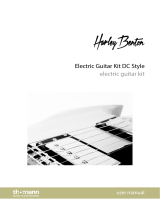 Harley Benton Electric Guitar Kit DC Style User manual
Harley Benton Electric Guitar Kit DC Style User manual
-
Harley Benton 255975 User manual
-
Harley Benton Bass Guitar Kit J-Style User manual
-
 Harley Benton Electric Guitar Kit ST-Style Owner's manual
Harley Benton Electric Guitar Kit ST-Style Owner's manual
-
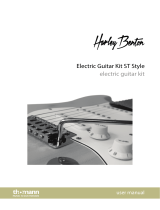 Harley Benton Electric Guitar Kit ST-Style User manual
Harley Benton Electric Guitar Kit ST-Style User manual
-
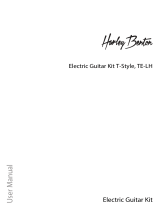 Harley Benton TE-LH User manual
Harley Benton TE-LH User manual
-
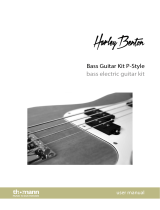 Harley Benton E-Bass Bausatz P-Style User manual
Harley Benton E-Bass Bausatz P-Style User manual
-
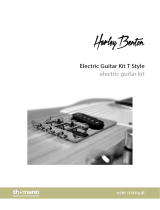 Harley Benton Electric Guitar Kit T-Style Owner's manual
Harley Benton Electric Guitar Kit T-Style Owner's manual
-
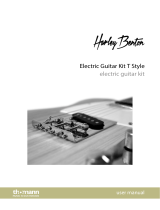 Harley Benton Electric Guitar Kit T-Style User manual
Harley Benton Electric Guitar Kit T-Style User manual
-
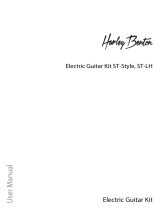 Harley Benton ST-LH User manual
Harley Benton ST-LH User manual







































